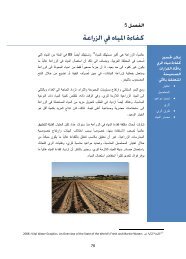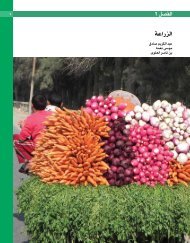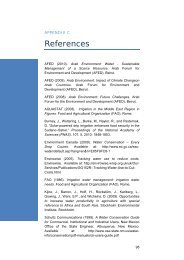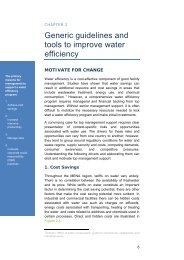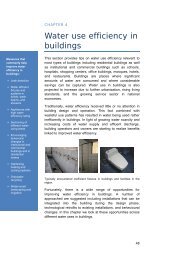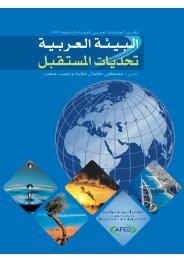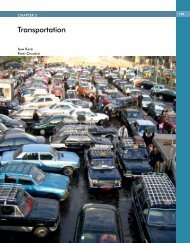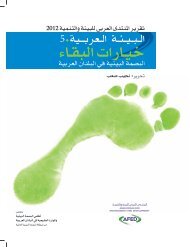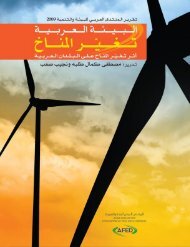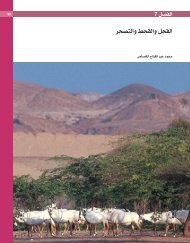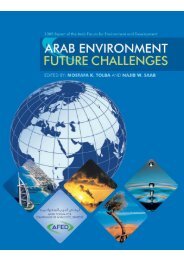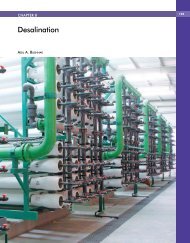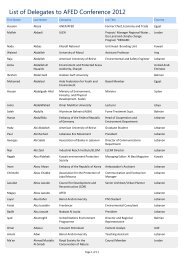Impact of Climate Change on Arab Countries - (IPCC) - Working ...
Impact of Climate Change on Arab Countries - (IPCC) - Working ...
Impact of Climate Change on Arab Countries - (IPCC) - Working ...
You also want an ePaper? Increase the reach of your titles
YUMPU automatically turns print PDFs into web optimized ePapers that Google loves.
ARAB ENVIRONMENT: CLIMATE CHANGE 95<br />
at a temperature <str<strong>on</strong>g>of</str<strong>on</strong>g> 26ºC this same protozoa takes<br />
<strong>on</strong>ly 13 days to incubate (Epstein 2004). A 2006<br />
study d<strong>on</strong>e in East Africa has revealed that a 3%<br />
increase in temperature in a certain regi<strong>on</strong> can<br />
mean an increase <str<strong>on</strong>g>of</str<strong>on</strong>g> 30-40% <str<strong>on</strong>g>of</str<strong>on</strong>g> mosquito abundance<br />
(Khamsi, 2006).<br />
Malik et al. (1998) report that in the southwestern<br />
part <str<strong>on</strong>g>of</str<strong>on</strong>g> Saudi <strong>Arab</strong>ia transmissi<strong>on</strong> <str<strong>on</strong>g>of</str<strong>on</strong>g> malaria<br />
occurs throughout the year with peaks associated<br />
with the rainy seas<strong>on</strong> and hot summers. Al-<br />
Mansoob and Al-Mazzah (2005) investigated the<br />
role <str<strong>on</strong>g>of</str<strong>on</strong>g> climate <strong>on</strong> the malaria incidence rates in<br />
Yemen. They found significant associati<strong>on</strong>s<br />
between climatic factors such as temperature, relative<br />
humidity, rainfall volume and wind speed<br />
with incidence <str<strong>on</strong>g>of</str<strong>on</strong>g> malaria. Similarly, Bassiouny<br />
(2001) reported that favourable meteorological<br />
c<strong>on</strong>diti<strong>on</strong>s (i.e., optimum temperature and relative<br />
humidity) led to the prol<strong>on</strong>gati<strong>on</strong> <str<strong>on</strong>g>of</str<strong>on</strong>g> the<br />
malaria transmissi<strong>on</strong> seas<strong>on</strong> to 8 m<strong>on</strong>ths a year in<br />
Fayoum Governorate in Egypt. Hassan et al.<br />
(2003) c<strong>on</strong>firmed these results and reported however<br />
that the most important predictor <str<strong>on</strong>g>of</str<strong>on</strong>g> risk in<br />
the Fayoum Governorate is hydrogeology. The<br />
study reported the spread <str<strong>on</strong>g>of</str<strong>on</strong>g> specific anopheles<br />
vectors in areas where they were previously<br />
absent.<br />
In New Halfa, Eastern Sudan, a time-series analysis<br />
study (Himeidan et al., 2007) showed that<br />
temperature and rainfall are driving forces <str<strong>on</strong>g>of</str<strong>on</strong>g> the<br />
spatial distributi<strong>on</strong> <str<strong>on</strong>g>of</str<strong>on</strong>g> the malaria vector<br />
Anopheles gambiae. In northern Sudan, surveys<br />
<str<strong>on</strong>g>of</str<strong>on</strong>g> breeding sites <str<strong>on</strong>g>of</str<strong>on</strong>g> the Anopheles arabiensis<br />
revealed a seas<strong>on</strong>al pattern for the larval populati<strong>on</strong><br />
which appeared to be linked to the rise and<br />
fall <str<strong>on</strong>g>of</str<strong>on</strong>g> the Nile River level (Ageep et al., 2009).<br />
Similarly, Hamad et al. (2002) reported seas<strong>on</strong>al<br />
transmissi<strong>on</strong> <str<strong>on</strong>g>of</str<strong>on</strong>g> malaria in Eastern Sudan, increasing<br />
with <strong>on</strong>set <str<strong>on</strong>g>of</str<strong>on</strong>g> rainy seas<strong>on</strong> and high humidity.<br />
ii) Other infectious diseases<br />
Other infectious diseases transmitted by vectors<br />
are also sensitive to climatic changes. The following<br />
are such examples:<br />
- Dengue (Breakb<strong>on</strong>e or Dandy Fever): This is<br />
an acute febrile disease caused by a flavivirus,<br />
which is transmitted by the bite <str<strong>on</strong>g>of</str<strong>on</strong>g> previously<br />
called Aedes mosquitoes (now named<br />
Stegomyia aegypti). Dengue is endemic<br />
throughout the tropics and subtropics threatening<br />
approximately <strong>on</strong>e-third <str<strong>on</strong>g>of</str<strong>on</strong>g> the world’s<br />
populati<strong>on</strong>. Its transmissi<strong>on</strong> increases with<br />
high rainfall, high temperature, and even, as<br />
some studies show, by drought (<strong>IPCC</strong>, 2007).<br />
- Cutaneous leishmaniasis (oriental sore or<br />
Aleppo Boil): The distributi<strong>on</strong> <str<strong>on</strong>g>of</str<strong>on</strong>g> the phlebotomine<br />
sandfly vector resp<strong>on</strong>sible for the<br />
infecti<strong>on</strong> with cutaneous leishmaniasis has<br />
changed in the past years. Other sandflies have<br />
also re-emerged in certain parts <str<strong>on</strong>g>of</str<strong>on</strong>g> the world<br />
(<strong>IPCC</strong>, 2007).<br />
- Schistosomiasis (Bilharziasis): This is a visceral<br />
parasitic disease caused by blood flukes <str<strong>on</strong>g>of</str<strong>on</strong>g> the<br />
genus Schistosoma. The schistosomes that<br />
affect humans are trematodes and they require<br />
freshwater snails as intermediate hosts.<br />
Schistosomiasis also may be affected by climatic<br />
factors, and there is some evidence that the<br />
‘freeze line’ has moved towards the north due<br />
to warmer temperatures (<strong>IPCC</strong>, 2007). This<br />
was supported by Mal<strong>on</strong>e et al. (1994) who<br />
used temperature data from satellite imagery to<br />
show that the range <str<strong>on</strong>g>of</str<strong>on</strong>g> S. mans<strong>on</strong>i in the Nile<br />
delta, Egypt, is expanding in the southern delta<br />
due to new irrigati<strong>on</strong> channels, a more reliable<br />
water supply and the physical-chemical stability<br />
since the completi<strong>on</strong> <str<strong>on</strong>g>of</str<strong>on</strong>g> the Aswan Dam.<br />
These changes have all provided a better fit to<br />
the hydrologic niche <str<strong>on</strong>g>of</str<strong>on</strong>g> the parasite. Moreover,<br />
the Bulinus truncates snail, which is the intermediate<br />
host <str<strong>on</strong>g>of</str<strong>on</strong>g> S. haematobium, is now able<br />
to tolerate several m<strong>on</strong>ths <str<strong>on</strong>g>of</str<strong>on</strong>g> drought and high<br />
temperatures. The correlati<strong>on</strong> between the<br />
density <str<strong>on</strong>g>of</str<strong>on</strong>g> Bulinus truncates with weather variati<strong>on</strong>s<br />
was m<strong>on</strong>itored by Khallaayoune and<br />
Laamrani (1992) in the Attaouia area in<br />
Morocco. It was shown that snail populati<strong>on</strong>s<br />
followed a cyclical pattern where high density<br />
occurred in summer. Temperature was c<strong>on</strong>sidered<br />
to be the most important factor that influenced<br />
the fluctuati<strong>on</strong>s in snails’ populati<strong>on</strong>s.<br />
Moreover, snails during the year <str<strong>on</strong>g>of</str<strong>on</strong>g> study<br />
(1987) were active throughout the year, due to<br />
the fact that the mean daily temperature was<br />
above 10 º C throughout the year.<br />
Observati<strong>on</strong>s <strong>on</strong> the pattern <str<strong>on</strong>g>of</str<strong>on</strong>g> snail infecti<strong>on</strong><br />
rates showed that the maximal rate <str<strong>on</strong>g>of</str<strong>on</strong>g> infecti<strong>on</strong><br />
happened in summer where the mean daily<br />
temperature was high and c<strong>on</strong>tact with water<br />
most frequent (Khallaayoune and Laamrani,<br />
1992).



